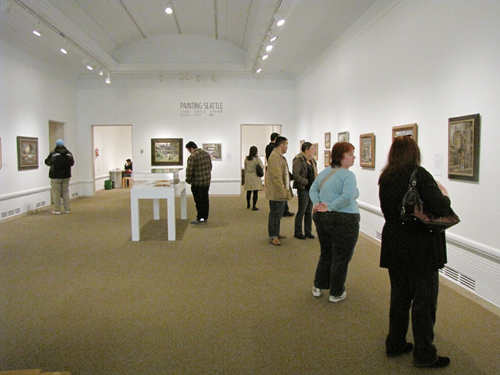By Andrew Hamlin
Northwest Asian Weekly

The “Painting Seattle” exhibit (Photos by Wendi Dunlap/Beacon Hill Blog)
As part of the Seattle Asian Art Museum’s “Painting Seattle” exhibit, canvases by Kamekichi Tokita occupy one showroom wall. Works from Kenjiro Nomura are exhibited on the opposite wall. The two men, friends, co-workers, and Japanese American Issei chroniclers of their hometown, shared much but also diverged as they went about leaving their legacies.
Exhibit curator Barbara Johns called Tokita and Nomura “very good artists whose work contributed meaningfully to the Seattle art scene and can be understood as a significant contribution to American art of its time.”
Professor Johns has published the book “Signs of Home: The Paintings and Wartime Diary of Kamekichi Tokita,” through the University of Washington Press.

“Fourth Avenue” by Kenjiro Nomura
Tokita (1897–1948) arrived in Seattle in 1919. Artistic since childhood, he painted commercially for the Noto Sign Company, where his co-worker and friend Kenjiro Nomura (1896–1956) also worked. The prominent artist George Tsutakawa (1910–1997) remembered that they both furnished painted backdrops for local kabuki performances.
The “Painting Seattle” exhibit includes an order pad from the Noto Sign Company, perfectly preserved. It sits, bright yellow, under glass, printed seemingly yesterday, with the business phone number in a now-antiquated style. It has two letters and five numbers, a reminder that the distant past was once the perfectly ordinary present.
During World War II, the U.S. government sent both men, along with their families, to the Minidoka War Relocation Center in Idaho. Nomura kept busy in the detention camp with sign painting. The “Signs of Home” book includes a Tokita canvas of a Minidoka boiler room, two small, occluded human figures subsumed into their industrial landscape.
But both men retained a love for their hometown. Looking at their framed canvases can seem a lot like looking out small windows, like portals to Seattle of a different era. Both men rendered their letters perfectly as part of their sign painting. But in their canvases, letters usually appear diffuse, as afterthoughts. Line and colors, not words in English, shape their visions.
Tokita preferred a softer overall focus and a greater interplay of subtle colors. Relative to those of Nomura, his scenes can seem a bit out-of-focus. But he always kept the larger image in mind, and succeeded always in his overall composition.
Nomura preferred a sharper line and focus. As Professor Johns writes in “Signs of Home,” his “colors are generally brighter than Tokita’s, and the palette a balance of warm and cool. Nomura’s painting of the same gas station scene as Tokita’s [painting] ‘Street’ makes ‘an instructive comparison… The effect is one of a pleasant urban vista, rather than the densely built urban enclosure that Tokita portrays.’”
Nomura outlived Tokita by several years and ventured into at least one area Tokita didn’t — abstract canvases. His two abstracts in the exhibit show balanced figures with vague resemblances to Japanese kanji. A third, “Harbor,” from 1953, blends stylized sea ships with jagged-lined suggestions of cityscape, almost like the seemingly chaotic squiggles in street graffiti.

“Street” by Kamekichi Tokita
Tokita’s regular diary entries end on April 28, 1942, the day he left for relocation. He notes simply that his pregnant wife had medical clearance to travel, and they spent all day packing. His paintings, and those of his friend Nomura, remain as quiet, lyrical love letters in paint to the community they cherished. (end)
“Painting Seattle: Kamekichi Tokita and Kenjiro Nomura” runs through Feb. 19 at the Seattle Asian Art Museum, 1400 East Prospect Street at Volunteer Park. For prices and hours, call 206-654-3100 or visit www.seattleartmuseum.org.
Andrew Hamlin can be reached at info@nwasianweekly.com.



